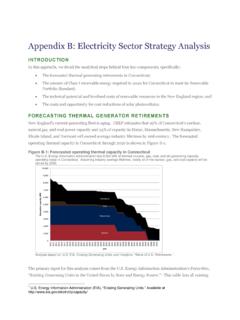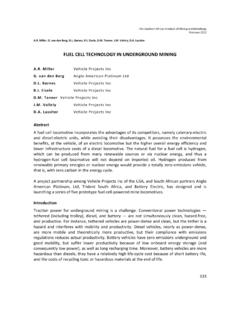Transcription of Hydrogen Production Using Solar Energy - JURP
1 1 Hydrogen Production Using Solar Energy Jeremiah F. Wilson1, Sesha S. Srinivasan2*, Bria M. Moore3, Lamont Henderson4, Sammie Ely III5, P. C. Sharma6, Department of Physics, Tuskegee University, Tuskegee, AL 36088 Email: *Corresponding Author: Telephone: 334-727-8996; Fax: 334-724-3917 Abstract The objective of this project is to create clean fuel for transportation Using Hydrogen powered by Solar Energy . Hydrogen has been generated by Solar photovoltaic (PV) array and then collected for data analysis to demonstrate efficiency of the Hydrogen Production in all the steps of the experiment. The Hydrogen produced from the electrolysis process was either stored in a metal hydride canister or directly fed into Proton Exchange Membrane (PEM) fuel Cell to generate electricity. A Hydrogen fuel cell remote control car has successfully designed, and demonstrates at least one hour operation per Hydrogen charging at room temperature.
2 Keywords: Solar Energy , Hydrogen Production , Electrolysis, PEM fuel Cell, Clean fuel Transportation, Hydrogen Storage, Metal Hydrides, Electrolyzer, Energy Efficiency. 1. Introduction Looking back in to history, it is clear that renewable Energy research has received the greatest quantity of funding during the gas price or availability crises1. The main source of Energy for 150 years has been fossil fuels, petroleum. However, the world is running out of this source rapidly and there are detrimental effects of its use pollution and economic impact2. A source without the dangerous by-products (greenhouse gases like CO2, CO, HC etc.) that is available at all times and renewable is needed: the answer is Hydrogen Energy ; the purpose of this work is to supply clean Energy to a remote control car.
3 The system shows that water electrolysis, powered by Solar Energy , creates hydrogen3. This chemical Energy then can be converted into mechanical Energy to power a remote control car. The Hydrogen can then be stored or transported. In this cycle, Hydrogen is an Energy carrier, which allows storage and transportation of inexhaustible Solar energy4. Petroleum has been a great resource and is widely used in many applications, like transportation and stationary generation of electricity. Many of these applications are of huge importance to the world. However, dependency on petroleum is a big problem for society because it is a non-renewable and polluting source. Since petroleum is non-renewable, it will deplete in only a matter of time.
4 So the big question is What will the world use for transportation or distribution when petroleum runs out? As mentioned above, petroleum is one of the most significant and important resources for transportation. Nowadays, most means of transportation use petroleum, such as cars, airplanes, motorcycles, and boats5. Engineers and scientists have been working hard trying to find other sources of Energy that they can use to replace petroleum. The world has many renewable resources such as Solar , wind, rain, tides and geothermal heat which are naturally replenished. The technologies associated with these natural energies are Solar power, wind power, hydroelectricity, biomass and biofuels for transportation purposes.
5 Natural Energy can help alleviate the world s petroleum shortage. There have been a few new developments such as the electric car and the Solar powered car. Solar Hydrogen fuel cell cars are one of the newest developments in progress today6. Hydrogen is a renewable source without hazardous byproducts. More importantly, Hydrogen is a source regenerating fuel ; it can be produced from water, intermediately stored, and finally used in either internal combustion engines or fuel cells to burn back to water. It is believed that if Hydrogen Solar cars are successfully developed and deployed; it will represent a huge milestone for renewable energies and the world will be safe from the ever threatening global warming effect7-9.
6 It will be Energy efficient with the advantage of storing Hydrogen reversibly in solid state materials, metal hydrides, carbon nanotubes, polymers and chemical complexes10. 2. Experimental Investigations Two important components of this project are (i) photovoltaics (PV) and (ii) electrolysis. A total of thirteen Solar panels (arrays) are utilized for this present study11. The first array has 117 modules with each angled at 5 degrees. The second array has 130 modules with each angled at 15 degrees. The third one has 130 modules with each angled at 25 degrees. For this project, Solar PV in array #1 was used to get the best performance for the Production of Hydrogen and oxygen. Additionally, array #1 provided an easy access for connection because it was designed for direct current, utility grid interconnection, capable of delivering a max current and 240V max voltage.
7 For this particular project, only one Solar PV of array #1 was utilized to produce 23V max voltage and 3A max current. Electrolyzers on the other hand, are the other main components of this particular design for producing Hydrogen . An electrolyzer uses a solid polymer electrolyte to transfer protons and water. When combined with catalysts, a membrane electrode assembly is formed. Then power is supplied by a source such as Solar photovoltaic. The electrolyzer then decomposes water and produces Hydrogen and oxygen gases. The system converts water into gaseous Hydrogen and oxygen Using electrolysis, creating heat with no hazardous by-products as represented by the overall chemical reaction3 2H2O + Electrical Energy (from Solar PV) 2H2 + O2.
8 To obtain Hydrogen by this mechanism, six electrolyzers were placed in series as shown in Figure 1. These electrolyzers are capable of utilizing various electrical sources such as Solar , hydro, turbine, etc. to produce Hydrogen and oxygen. Hydrogen can be used to power fuel cells and oxygen can be released back in to the atmosphere. In this particular experiment, Hydrogen was used to power a remote control car. Figure 1: Hydrogen Production set up Using Solar PV electrolysis After creating Hydrogen from the Solar PV, the Hydrogen car was designed and built without Using conventional batteries. The fabrication of the car began by calculating the potential voltage and current required to power the remote control car.
9 It was determined that the car would power at 6 volts and 2 amps. These calculations helped to determine that a fuel cell which generates at least 12 watts of power was needed. Horizon fuel Cell Technologies12 in Singapore had exactly what the design required and was able to ship the Hydrogen fuel cell kit at a short notice. The current-voltage (I-V) characteristics of the fuel cell are shown in Figure 2. Figure 2: Current-Voltage (I-V) characteristics of the PEM fuel Cell (Courtesy: Horizon fuel Cell Technologies) The second step was to design a fluid system that could transfer Hydrogen from a high pressure tank to low pressure (metal hydride) tank. Swagelok13 coupling devices (Figure 3(a)) made of stainless steel that could withstand high pressure over 5000 psig were used to do this.
10 These devices are also capable of transporting flammable gases such as Hydrogen . This particular design could withstand high pressures (pre-tested with 300 psig), but even with high pressure viability, safety was still an important factor when experimenting with such flammable gases. The third step was to activate the metal hydride tanks (20L standard). Each tank contains 100 grams of a metal hydride ( LaNi5 type) that acts as a sponge for Hydrogen sorption after it is activated. To activate this metal hydride, the tanks were connected to the fluid design. Then the low pressure regulator was set to 30 bar (435 psig). After waiting 80 minutes, the pressure was released to about 10 bar (100 psig) and increased the Hydrogen pressure back to thirty bars.









